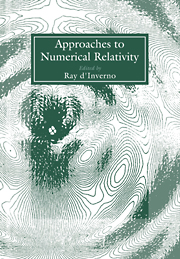Book contents
- Frontmatter
- Contents
- Contributors
- Introduction
- Preface
- PART A THEORETICAL APPROACHES
- PART B PRACTICAL APPROACHES
- Numerical asymptotics
- Instabilities in rapidly rotating polytropes
- Gravitational radiation from coalescing binary neutron stars
- “Critical” behaviour in massless scalar field collapse
- Godunov-type methods applied to general relativistic stellar collapse
- Astrophysical sources of gravitational waves and neutrinos
- Gravitational radiation from 3D gravitational stellar core collapse
- A vacuum fully relativistic 3D numerical code
- Solution of elliptic equations in numerical relativity using multiquadrics
- Self-gravitating thin discs around rotating black holes
- An ADI scheme for a black hole problem
- Time-symmetric ADI and causal reconnection
- The numerical study of topological defects
- Computations of bubble growth during the cosmological quark-hadron transition
- Initial data of axisymmetric gravitational waves with a cosmological constant
- PANEL DISCUSSION
“Critical” behaviour in massless scalar field collapse
Published online by Cambridge University Press: 15 December 2009
- Frontmatter
- Contents
- Contributors
- Introduction
- Preface
- PART A THEORETICAL APPROACHES
- PART B PRACTICAL APPROACHES
- Numerical asymptotics
- Instabilities in rapidly rotating polytropes
- Gravitational radiation from coalescing binary neutron stars
- “Critical” behaviour in massless scalar field collapse
- Godunov-type methods applied to general relativistic stellar collapse
- Astrophysical sources of gravitational waves and neutrinos
- Gravitational radiation from 3D gravitational stellar core collapse
- A vacuum fully relativistic 3D numerical code
- Solution of elliptic equations in numerical relativity using multiquadrics
- Self-gravitating thin discs around rotating black holes
- An ADI scheme for a black hole problem
- Time-symmetric ADI and causal reconnection
- The numerical study of topological defects
- Computations of bubble growth during the cosmological quark-hadron transition
- Initial data of axisymmetric gravitational waves with a cosmological constant
- PANEL DISCUSSION
Summary
Abstract. The results of a detailed numerical investigation of the strong-field, dynamical behaviour of a collapsing massless scalar field coupled to the gravitational field in spherical symmetry are summarized. A variety of non-linear phenomena suggestive of a type of universality in the model have been discovered using a finite difference approach combined with an adaptive mesh algorithm based on work by Berger & Oliger. A derivation of the equations of motion for the system is sketched, the adaptive algorithm is described, and representative examples of the strong-field behaviour are displayed.
INTRODUCTION
The problem of the collapse of a massless scalar field coupled to the Einstein gravitational field in spherical symmetry has been studied in considerable detail, both analytically (Christodoulou 1986a, 1986b, 1987a, 1987b), and through numerical work (Choptuik 1986, 1989, 1991, Goldwirth & Piran 1987, Goldwirth et al 1989, Gómez & Winicour 1989, 1992, Gómez et al 1992). In many ways, the system provides an ideal model for addressing a variety of basic issues in numerical relativity. The scalar field provides the model with a radiative degree of freedom which is necessarily absent from any “dynamics” of the Einstein (or Maxwell) field in spherical symmetry. At the same time, by suitable choice of initial data, the self-gravitation of the scalar field can be made arbitrarily strong, so that processes such as curvature scattering of radiation and black-hole formation can be studied.
- Type
- Chapter
- Information
- Approaches to Numerical Relativity , pp. 202 - 222Publisher: Cambridge University PressPrint publication year: 1992
- 13
- Cited by

